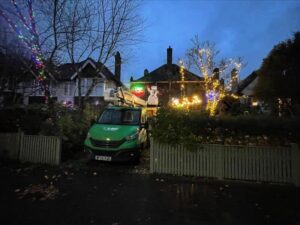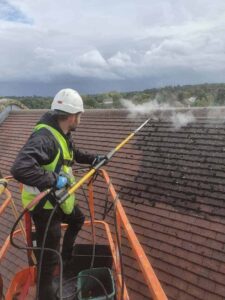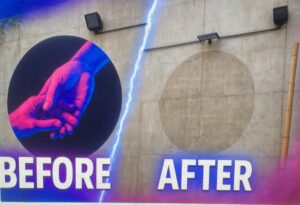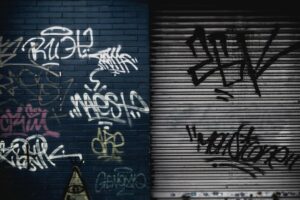Graffiti removal is an essential service for maintaining the aesthetic appeal and value of properties, while fostering community pride. This blog post delves into various aspects of graffiti removal, providing valuable insights to property managers, council workers, and housing association representatives.
We will explore the impact of graffiti on communities by examining its effects on property values and community pride. We will also discuss different types of graffiti removal methods such as hydrogel-based techniques, chemical approaches, and physical interventions.
Additionally, we’ll analyse cost considerations for these services while evaluating their effectiveness. A comparison between laser-based approaches and conventional options will be presented along with a discussion about Elephant Snot®, a versatile solution in the field of graffiti removal.
Lastly, we’ll cover challenges associated with removing graffiti from porous surfaces as well as preserving painted areas during the process. Legal considerations surrounding obtaining permissions and approvals are also addressed to ensure compliance with local regulations.
Table of Contents:
- The Impact of Graffiti on Communities
- Effects on Property Values
- Influence on Community Pride
- Types of Graffiti and Removal Methods
- Innovative Solutions for Environmentally Friendly Graffiti Removal
- Cost Considerations in Choosing Effective Graffiti Removal Products
- Specialized Products for Different Surface Types
- Legal Considerations for Graffiti Removal
- FAQs in Relation to Graffiti Removal
- Conclusion
The Impact of Graffiti on Communities
Graffiti, often seen as a form of vandalism, can have negative effects on the perception and overall well-being of an area. By working with councils, housing associations, and property managers across London to provide graffiti removal services, LBC Exterior Cleaning helps create cleaner and more attractive environments for residents.
Effects on Property Values
Unsightly graffiti can lower property values in affected areas by creating an impression of neglect or disorder. This is particularly concerning for affluent homeowners who may see their investments depreciate due to unwanted markings. A study conducted by Urban Studies Journal found that removing graffiti from properties could lead to increased value within the surrounding neighbourhood.
Influence on Community Pride
- Safety concerns: The presence of graffiti may be perceived as a sign that criminal activity is prevalent in the area, leading residents to feel unsafe.
- Aesthetic appeal: Unsightly tags and scribbles detract from the visual appeal of public spaces like parks or community centres where people gather.
- Deterioration: Prolonged exposure to graffiti can cause surfaces such as brickwork or painted walls to deteriorate faster than they would under normal conditions.
To counter these negative impacts, it’s essential for local authorities and property managers alike to invest in professional graffiti removal services like those offered by LBC Exterior Cleaning. With expertise in various methods tailored specifically to the type of graffiti and surface involved, LBC Exterior Cleaning ensures that communities across London can maintain their aesthetic appeal and foster a sense of pride among residents.
Graffiti can have a major influence on the environment, and it is critical to comprehend its consequences in order to come up with successful removal plans. By understanding different types of graffiti and exploring various methods for removing them, we can ensure that our communities remain safe and clean.
Types of Graffiti and Removal Methods
Graffiti comes in various forms, each requiring a different approach for effective removal. Factors such as surface type and the age or thickness of paint layers involved determine which method is best suited for each situation. In this section, we will discuss the common types of graffiti and their corresponding removal techniques.
Tagging vs. Street Art
Tagging refers to simple signatures or marks left by vandals on walls, while street art encompasses more elaborate designs created with artistic intent. While both can be considered graffiti, they often require different approaches when it comes to removal due to varying levels of complexity and materials used.
Chemical Removal Techniques
Chemical removal methods, such as solvents or paint strippers, are commonly used to dissolve graffiti from surfaces like metal or glass without causing damage. These chemicals work by breaking down the bonds between the paint molecules and the substrate material.
Physical Removal Processes
- Sanding: This involves using abrasive materials like sandpaper to remove graffiti from wooden surfaces manually.
- Blasting: High-pressure water jets (also known as power washing) can be an effective way to remove stubborn graffiti from brickwork or concrete surfaces without causing harm.
- Laser cleaning: A relatively new technique that uses lasers at specific wavelengths (laser ablation) to remove graffiti from surfaces without damaging the underlying material.
Biological Cleaning Solutions
Biodegradable cleaning agents, such as enzymes or microorganisms, can be utilized to disintegrate and expel graffiti in an eco-friendly way. These solutions are particularly useful for delicate surfaces like limestone or marble that may be damaged by harsher chemical treatments.
Having a thorough knowledge of graffiti types and removal techniques is essential for property managers to successfully tackle the task of graffiti eradication. Moving on from this, innovative solutions such as hydrogel technology are now available which offer environmentally friendly alternatives to conventional cleaning processes.
Innovative Solutions for Environmentally Friendly Graffiti Removal
Graffiti removal methods have evolved over the years, with researchers and companies constantly seeking more efficient and environmentally friendly solutions. One such innovation is the use of hydrogel technology, developed by Michele Baglioni at the University of Florence. Hydrogels enable cleaning agents to remove only the top layer of paint without affecting underlying artwork or surfaces.
Hydrogel Technology
Hydrogels are water-based gels that can absorb and hold large amounts of liquid. In graffiti removal applications, they work as a carrier for cleaning agents, allowing precise control over their application. The hydrogel ensures that only unwanted graffiti layers are removed while preserving any valuable artwork beneath it.
Benefits Compared to Conventional Methods
- Eco-friendly: Hydrogels minimize residues left behind during traditional cleaning processes, reducing environmental impact.
- Selective removal: This innovative approach allows for targeted elimination of specific paint layers without damaging underlying surfaces or art pieces.
- Precision: By controlling the application process accurately, hydrogels offer improved results compared to conventional techniques like chemical solvents or abrasive blasting methods.
- Safety: As an added bonus, using hydrogels reduces potential health risks associated with exposure to harsh chemicals often used in other graffiti removal products.
The adoption of eco-friendly technologies like hydrogels not only benefits our environment but also helps preserve valuable artworks hidden beneath unsightly graffiti markings. Further advancements in this field could bring about even more efficient methods of graffiti removal. For more information on hydrogel technology and its applications, visit this research article by Michele Baglioni and his team.
Innovative techniques for environmentally conscious graffiti removal provide an economical and eco-friendly way to address the issue without sacrificing quality. With this in mind, it is important to consider the various costs associated with different methods when choosing an effective product; let’s explore how Elephant Snot® compares against conventional approaches.
Cost Considerations in Choosing Effective Graffiti Removal Products
The cost associated with removing graffiti is significant. San Francisco city alone spends $20 million annually on this task. It’s crucial to measure the cost-effectiveness accurately before committing resources towards specific products or approaches since improper techniques can lead to lasting damage, such as Stonehenge.
Comparing costs between laser-based approaches vs conventional options
Laser-based graffiti removal methods, such as those using laser ablation technology, are often more expensive upfront but may provide long-term savings due to their precision and reduced need for chemical agents. Conventional options like pressure washing and chemical treatments can be less costly initially but may require multiple applications, increasing overall expenses.
Elephant Snot® product overview
Elephant Snot® is a popular graffiti removal product that effectively removes paint from various surfaces without causing harm. Its unique formula allows it to penetrate deep into porous materials, lifting away unwanted markings while leaving the underlying surface intact. Although Elephant Snot® may have a higher price point than some other products on the market, its effectiveness makes it a worthwhile investment for property managers seeking an efficient solution.
- Eco-friendly: Elephant Snot® contains biodegradable ingredients and produces minimal waste during application.
- Versatile: This product works well on multiple surface types, including brick, concrete, and metal.
- Effective: Elephant Snot® has a proven track record of successfully removing graffiti without causing damage to the underlying surface.
When selecting graffiti removal products, it is important to factor in the associated costs for optimal decision-making. By comparing different methods and understanding their associated expenses, you can make informed choices that lead to cleaner environments while minimizing financial strain on councils, housing associations, and property managers alike.
When looking into the expense of graffiti removal products, it is wise to assess both laser-based and traditional solutions in order to make an educated selection. Specialized products such as Taginator and Tagaway can also be used on different surface types for maximum efficiency.
Key Takeaway:
Choosing the right graffiti removal product is crucial to avoid lasting damage and high costs. While laser-based methods may be more expensive upfront, they can provide long-term savings, while Elephant Snot® offers an effective and eco-friendly solution for removing paint from various surfaces without causing harm.
Specialized Products for Different Surface Types
Graffiti removal can be a challenging task, especially when dealing with various surface types. It is essential to use specialized products designed specifically for the substrate in question to ensure efficient eradication without causing additional harm or leaving residue traces behind afterward.
Masonry Surfaces and Taginator
Porous surfaces like masonry materials (e.g., brick) require unique solutions such as Taginator. This powerful graffiti remover is specially formulated to penetrate deep into porous substrates, effectively breaking down paint layers while preserving the integrity of the underlying material. The result is a clean and undamaged surface free from unsightly graffiti markings.
Painted Surfaces and Tagaway
In contrast, painted areas may benefit more from alternative formulations catered explicitly towards them. One such product is Tagaway, which has been developed specifically for removing graffiti from smooth painted surfaces without damaging the original paint layer underneath. By using this targeted solution, property owners can maintain their properties’ aesthetic appeal while eliminating unwanted vandalism.
- Key Takeaways:
- Choose specialized products based on surface type to maximize efficiency and minimize damage during graffiti removal processes.
- Consider using Taginator for masonry surfaces due to its ability to penetrate deeply into porous materials while preserving their integrity.
- Opt for Tagaway when working with painted surfaces since it’s designed not only to remove graffiti but also protect underlying paint layers in the process.
By selecting the appropriate product for each surface type, property managers and homeowners can effectively combat graffiti while preserving their properties’ appearance. In doing so, they contribute to creating cleaner, healthier environments for residents across London.
Specialized products for different surface types ensure that the graffiti removal process is done efficiently and effectively. Legal considerations must also be taken into account when removing graffiti, as certain restrictions may apply to historic sites or contemporary street art.
Legal Considerations for Graffiti Removal
In some regions, government approval may be necessary before attempting any graffiti removal actions due to potential historical or cultural significance associated with specific instances. This could include Apollo 16’s scribbles found within its reentry capsule or even contemporary street art pieces recognized for their artistic value by local communities and authorities alike.
Obtaining Permission for Historic Sites
Prior to removing graffiti from historic sites, it is essential to consult with the relevant governing bodies and obtain permission if required. These organizations might include Historic England, the Cadw in Wales, or other regional heritage groups responsible for preserving historically significant structures. Neglecting to gain permission can lead to legal repercussions and impair the site’s authenticity.
Recognizing the Value of Contemporary Street Art
Appreciation of street art as an important form of creative expression has grown in recent years, with artists such as Banksy gaining recognition for their thought-provoking works on public spaces. Artists like Banksy have gained international recognition and acclaim for their thought-provoking works on public spaces across London and beyond.
- Educate yourself: Before deciding whether a piece should be removed, research its origins and determine if it holds any cultural significance within your community.
- Contact local authorities: Reach out to your council representatives or neighborhood associations who may have more information about a particular artwork’s importance.
- Weigh up pros & cons: Consider the potential benefits of preserving street art, such as attracting tourists or promoting local pride, against any negative impacts it may have on property values or public safety.
By taking these factors into account and collaborating with councils, housing associations, and property managers across London, graffiti removal services can help create cleaner and more attractive environments for residents while respecting the cultural value of contemporary street art.
Key Takeaway:
Before attempting any graffiti removal, it is important to obtain permission from relevant governing bodies for historic sites. Additionally, recognizing the cultural value of contemporary street art and weighing up its pros and cons can help create cleaner environments while preserving artistic expression.
FAQs in Relation to Graffiti Removal
Why Should Graffiti Be Removed?
Graffiti should be removed because it can negatively impact property values, diminish community pride, and contribute to an overall decline in the neighborhood’s aesthetic appeal. Prompt removal also discourages future vandalism by showing that such acts will not be tolerated.
What Are Some Solutions to Remove Graffiti?
There are various solutions for removing graffiti, including chemical methods (e.g., Elephant Snot®), physical approaches (e.g., pressure washing), and laser-based techniques. The choice of method depends on factors like surface type, underlying artwork preservation, and cost considerations.
What Are the Three Most Common Graffiti Removal Methods?
The three most common graffiti removal methods include:
- Chemical: Using specialized products like Elephant Snot® to dissolve paint without damaging surfaces;
- Physical: Pressure washing or sandblasting away unwanted paint; and
- Laser-Based: Employing advanced technology to vaporize paint layers without harming substrates.
At LBC Exterior CLEANING, we specialize in removing graffiti from all types of surfaces. Our team of experts uses the latest techniques and equipment to ensure that your property is restored to its original condition. Contact us today to learn more about our services.
Conclusion
Removing graffiti is crucial for maintaining the aesthetic appeal of communities and preserving property values. There are various methods available, including hydrogel-based techniques, chemical removal options, physical approaches, and laser-based solutions. Cost considerations must be evaluated to ensure cost-effectiveness while preserving painted areas during the removal process.
It is essential to consider legal requirements when removing graffiti from historical sites or public spaces. LBC Exterior CLEANING offers a versatile solution with Elephant Snot® that can effectively restore vandalised surfaces.
If you need professional graffiti removal services in the UK, contact LBC Exterior CLEANING today to learn more about our comprehensive range of cleaning solutions.









